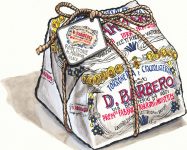French Toasty Memories
My earliest memory is of French Toast. Given that it’s my first, and a happy one, it’s one that I’ve polished, studied, and restored, time and time again. I distinctly remember waking up to the sound of my mom’s quick steps on the sidewalk, leaving at dawn for her waitressing job at a now non-existent diner in Leslie, Michigan.
I believe that I smiled before I even opened my eyes. I sat up, jumped out of bed, and excitedly toddled my three-year-old self into the kitchen where my grandmother was exactly where I counted on her to be: over the stovetop, with the sizzle of French Toast warmly enveloping me.
French Toast is one of those foods that I learned how to make with Wonderbread as a child, and hadn’t revisited. With the recent passing of my grandmother and the holiday season stirring up family memories, I decided to bring this dish into adulthood. As I was doing my Googling of recipes, it surprised me to discover that this nostalgic, simple food has quite the footprint.
In France, the dish is called “pain perdu,” meaning “lost bread”. This refers to the fact that it’s made from stale bread that would otherwise be thrown away. Despite its name, this dish didn’t originate in France.
The earliest variation of French Toast can be traced back to the Roman Empire. It’s first mention comes from a fourth-century Roman cookbook. Referred to as “Aliter Dulcia” (“another sweet dish”), Romans would soak bread in milk and then fry it in butter.
So, what of the name “French Toast?” Legend has it that an innkeeper in Albany, New York named Joseph French created his own spin on it in the year 1724, and called it the ‘French Toast’, instead of French’s toast, after his own last name. Perhaps more likely is that this dish was popularized in America by French immigrants, and earned its name that way.
I find the origins of this toast and its name to be far less interesting than the fact that my seemingly quaint and insular childhood memory is likely shared worldwide. “French Toast” has countless names and variations globally.
Eggy bread. Bombay toast.
Gypsy toast. Poor Knights of Windsor.
In Hong Kong, French toast is absolutely soaked in butter, even after being fried in it, and is drizzled with condensed milk or syrup. In Canada, it’s fried in butter after being soaked in a sweetened cinnamon custard, and of course, topped with maple syrup. In Morocco, they slice flatbread into long pieces, dusting it with powdered sugar, and dip it into syrup. Regardless of where in the world you find it, it seems as though French Toast is typically a happy, buttery, childhood treat.
If you’d like to join me in giving this dish an adult makeover, be sure to stop into the Zingerman’s Bakehouse to pick up a loaf of Challah. Enjoy it fresh with some butter first (my personal favorite is the Kerrygold butter, sold at the Deli!), but slice up the rest and let it sit overnight (this keeps the bread from absorbing too much egg and getting soggy!). This makes for the best French Toast bread.
Another great twist is to add a quarter cup of fresh OJ as well as a teaspoon of orange zest – this addition to the classic American recipe helps to cut through the richness.
Michelle Abbey, Zingerman’s Coffee Company Marketing Manager




Zingerman’s Art for Sale